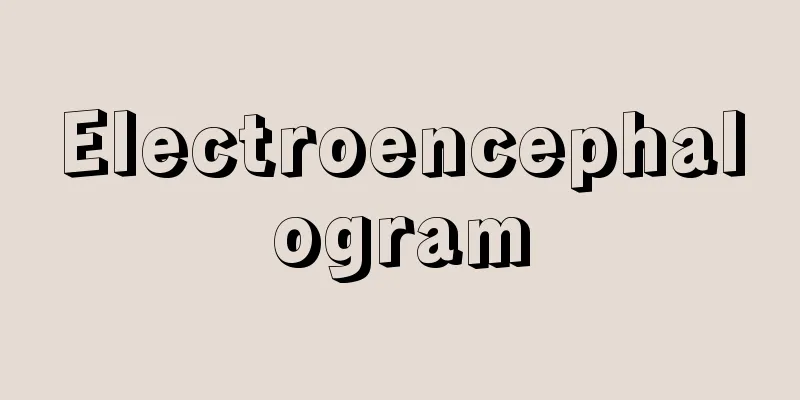Electroencephalogram

|
(1) Electroencephalogram (EEG) is a recording, often from the body surface, of electrical potential changes that occur with the activity of brain nerve cells. An electroencephalograph is a highly sensitive amplifier that amplifies minute electrical potential changes of several tens of μV and records them as a deflection of about a few mm. EEG can provide information about brain function, especially its activity. Surface electrodes can record electrical potential changes on the brain surface, which are thought to record the sum of electrical potential changes in the dendrites densely distributed on the surface. In recent years, due to the development of functional imaging, its usefulness has tended to be overlooked, but the two work in a complementary manner, and EEG is extremely useful for determining the prognosis of comatose patients, evaluating brain function in encephalopathy, and testing for epilepsy. It is an essential item for determining brain death, and the standard is a flat EEG that shows no brain activity exceeding 2 μV. There are two types of lead acquisition methods: unipolar and bipolar. With the unipolar lead acquisition method, an active electrode is attached to the scalp according to the International 10-20 system (Figure 15-4-2), and a reference electrode is attached to the same side earlobe ( A1 + A2 ), and the potential difference is measured. With the bipolar lead acquisition method, the potential difference between the two active electrodes on the scalp is measured. The resulting waveforms are called slow waves at 7 Hz or less, fast waves at 14 Hz or more, low voltage at 20 μV or less, and high voltage at 100 μV or more. A normal EEG i) Normal EEG in an awake adult When awake with the eyes closed, alpha waves (8-13 Hz) appear predominantly in the occipital lobe. This is called the basic wave. When the eyes are opened, the alpha waves disappear, and beta waves (14-25 Hz) and low-amplitude fast waves become predominant. Although theta waves (4-7 Hz) are seen, they are in small amounts, and delta waves (3 Hz or less) are absent. Normally, asymmetry, slow waves, and sudden waves are not seen, and their presence should be suspected as indicating some kind of abnormality. ii) Pediatric EEG Delta waves are seen shortly after birth, and theta and alpha waves are added as the child grows. After about age 3, theta waves become the basic wave, and thereafter the frequency of the basic wave increases at a rate of about 1 Hz per year. From about age 4 to 8, alpha waves become the basic wave. Compared to adults, there is a tendency for high amplitude slow waves, and there may be a difference between the left and right sides. At around age 20, the EEG becomes an adult wave. iii) EEG in the elderly: From the age of 60 onwards, the fundamental frequency of alpha waves in EEG approaches 8 Hz. For those aged 60-80, the average is 9 Hz, and for those aged 80 or over, it is 8 Hz. Theta waves also increase in number. As there are large individual differences, care must be taken when diagnosing dementia. iv) Sleep EEG changes due to sleep can be divided into four stages. In stage I sleep, alpha waves disappear and the brain waves become wavy overall, with low-amplitude theta waves dominating. In stage I sleep, which is a little deeper, single, blunt, high-voltage slow waves or hump or vertex sharp transients consisting of two or three connected waves appear significantly in the center and parietal areas on both sides. Stage II is the stage where sleep spindles and K-complexes appear; bursts of 12-14 Hz waves are called spindles, and the high-amplitude slow waves preceding the spindles are called K-complexes. In stage III, spindles disappear and theta waves and delta waves appear in roughly equal proportions. In stage IV, theta waves decrease and the brain waves are dominated by delta waves. After stage IV continues for a while, it suddenly changes to being dominated by low-amplitude fast waves and theta waves, and at the same time rapid eye movement (REM) appears, entering the REM sleep stage. When sleep is recorded over the course of a night, it is observed to shift repeatedly from stage I to stage IV to REM sleep. In adults, there is a certain pattern, with an average of three REM sleep periods. Sleep disorders are analyzed using overnight polysomnography, which simultaneously records electroencephalograms, respiration, nystagmus, and electromyograms. b. Abnormal EEG i) Slow waves Diffuse slow waves (the overall appearance of slow waves of 7 Hz or less) are the most common abnormality. They appear in a variety of encephalopathies, including poisoning, metabolic, hypoxic, degenerative diseases, and inflammation. Triphasic waves (Figure 15-4-3A), which are triphasic from Yin (upward) ⇒ Yang (downward) ⇒ Yin (upward), often appear in patients with hepatic encephalopathy (50% of patients with triphasic waves have hepatic encephalopathy). Localized slow waves suggest localized brain dysfunction due to tumors, cerebral infarction, etc., and more than 70% of patients who exhibit this have some kind of abnormality on imaging. The slower frequency is considered to be the affected side, and in cerebral infarction, slow waves corresponding to the site of the lesion are observed. In cerebral hemorrhage and subarachnoid hemorrhage, diffuse slow waves reflecting impaired consciousness are observed. The electroencephalographic changes seen in dementia are basically signs of functional decline, with irregularities and slowing of basic waves, such as a decrease in alpha waves, an increase in slow waves, and a decrease in frequency. In many cases with dementia, despite severe symptoms, the electroencephalographic findings are close to normal. However, there is a large degree of individual variability between electroencephalograms and clinical symptoms, so they do not always match. ii) Fast beta and gamma waves (26 Hz This condition is characterized by a high number of fast waves such as those mentioned above, and is seen when taking psychotropic drugs and in cases of endocrine disorders such as hyperthyroidism and Cushing's syndrome. iii) Epileptiform EEG (An example is shown in Figure 15-4-3B) A spike is a sharp electrical potential lasting 20 to 70 msec, while a sharp wave is a potential change lasting 70 to 200 msec. When spikes or sharp waves are observed between seizures, it suggests the presence of epileptic action potentials accompanied by focal or generalized convulsions. In interictal EEG of simple partial seizures with a cortical focus, spikes may appear in the same area. Rhythmic spikes are observed during seizures. Regarding localization, since the epilepsy-specific potential is usually negative (upward), in unipolar lead acquisition, the point indicated by the channel with the largest amplitude is the point (focus) where the epilepsy-specific potential is at its maximum, and in bipolar lead acquisition, the point (focus) where the epilepsy-specific potential is at its maximum is the point (focus) between two channels with inverted phase. In temporal lobe epilepsy, rhythmic θ-band waves appear in the center of the temporal lobe. Even in myoclonus patients, paroxysmal discharges such as spikes may be seen just before myoclonic muscle discharges. These are irregular waves that occur about once every 3 to 4 seconds, and are typically followed by slow waves two or three times. During absence seizures, complex waves of 3 Hz spikes and blunt slow waves (spikes and slow waves) appear repeatedly in all leads, which is characteristic. ⅳ) Periodic synchronous discharge (PSD) (Figure 15-4-3C) Abnormal waves that appear periodically on the electroencephalogram are called periodic abnormal electroencephalograms/complexes (PC), and among these, those that appear with a short period (around 1 second) that is characteristic of Creutzfeldt-Jakob disease are called PSD. PSD appears in 90% of cases of Creutzfeldt-Jakob disease and is relatively characteristic. However, similar electroencephalographic findings can also be seen in metabolic encephalopathy, so it is not an absolute condition. Furthermore, typical PSD is not usually seen in new Creutzfeldt-Jakob disease. A PSD with a long period (around 3 seconds) is seen in subacute sclerosing panencephalitis. v) Periodic lateralized epileptiform discharge (PLED) PLED is a waveform in which PC appears on one side. It is an acute eccentric lesion that reflects relatively severe brain dysfunction. Thirty-five percent of cases are associated with cerebral infarction, 26% with space-occupying lesions such as tumors, and the rest are associated with inflammation and hypoxic encephalopathy. ⅵ) Hypsarrhythmia This is a specific epileptic abnormal electroencephalogram seen in patients with infantile spasms (West syndrome). High-amplitude slow waves and spikes appear irregularly, and are clearly seen in the majority of patients both during wakefulness and sleep. This pattern is seen from about age 30 to 40, after which it often transitions to a slow spike and wave pattern. vii) Impaired consciousness and electroencephalogram (EEG) EEG is an extremely useful diagnostic method for patients with impaired consciousness because it is non-invasive and can be performed in the patient's room. When consciousness is impaired, cerebral cortical function declines, alpha waves shift to a lower frequency range and decrease, while diffuse or multifocal slow waves become mixed in. This corresponds to the depth of the impaired consciousness and can be an indicator of prognosis. In cases of widespread damage to the pons (such as pontine hemorrhage), alpha waves may appear on the EEG even though the patient is in a deep coma. This type of coma is called alpha coma. On the other hand, spindle waves may be observed in a coma state, which is called spindle coma. This type of coma has a relatively good prognosis compared to alpha coma. c. Activated EEG Even when no obvious abnormal findings are found in the EEG when the subject is awake and at rest with eyes closed, abnormal EEG may be detected by exposing the subject to a certain type of stimulation or stress. In a typical test, brain cells are activated to make it easier to detect EEG abnormalities, and the degree of activation is checked to see if it is within the normal range. i) Eye open/close activation When the eyes are opened during rest with the eyes closed, the amplitude of alpha waves decreases rapidly and diffuse low amplitude fast waves come to the foreground. This phenomenon is called alpha-blocking. As it indicates the reactivity and activity level of the cerebral cortex, it is useful for patients suspected of having mild disorders of consciousness. In patients with narcolepsy, paradoxical alpha-blocking may be observed, in which opening the eyes actually increases alpha waves. ii) Hyperventilation Hyperventilation reduces arterial blood PCO2 , which causes cerebral blood vessels to constrict and the brain to enter a state of ischemia. This causes an increase in the amplitude of the EEG and a noticeable slowing of the waves; this is called build-up. Mild build-up is also seen in healthy people, but it is abnormal when it is significant or when it takes a long time for the build-up to disappear. In people with occlusion of the circle of Willis (moyamoya disease), a significant build-up can be seen after hyperventilation, and after the EEG image returns to normal after hyperventilation has stopped, slowing of the waves again (rebuild-up) can be seen. iii) Photoactivation Healthy individuals rarely show changes in their brain waves due to light stimulation. The appearance of waves that match the frequency of light stimulation or a multiple of it is called photic driving. This tends to appear from the top to the back of the head, and is of diagnostic value especially when there is a difference between the left and right sides. A disease in which epileptic seizures are caused by light stimulation is called photosensitive epilepsy. ⅳ) Sleep activation: Since abnormal brain waves tend to appear during sleep, brain waves are also activated by sleep. There are two methods for inducing sleep: natural sleep and drug-induced sleep. [Hitoshi Mochizuki and Yoshikazu Ukawa] ■ References <br /> Hara, Tsunekatsu, Akiyama, Yasuko, et al.: Guide to Requesting EEG Tests: How to Interpret the Findings, Medical Publishing, Tokyo, 1996. Teruo Okuma: Clinical Electroencephalography, 4th ed., Igaku-Shoin, Tokyo, 1991. Electrode placement according to the International 10-20 system "> Figure 15-4-2 Examples of abnormal EEG Figure 15-4-3 Source : Internal Medicine, 10th Edition About Internal Medicine, 10th Edition Information |
|
(1)脳波 脳波(electroencephalogram:EEG)とは,脳神経細胞の活動に伴って生じる電位変化を多くの場合体表から記録したもので,脳波計は高感度の増幅器であり,数十μVの微小な電位変化を増幅して数mm程度の振れとして記録する.脳波により脳の機能,特にその活動性について情報を得ることができる.表面電極によって記録できるのは脳表面の電位変化で,表層に密に分布する樹状突起の電位変化の総和を記録していると考えられている.近年機能画像法の発達などで,その有用性が軽視される傾向があるが,両者は相補的に働くもので,昏睡状態の患者の予後判定,脳症における脳機能評価,てんかんの検査などには,脳波が非常に有用である.脳死判定には必須項目となっており,2 μVをこえる脳由来の活動を認めない平坦脳波が基準である. 導出法には,単極導出法と双極導出法がある.単極導出法は,国際10-20法(図15-4-2)に従い頭皮上に活動電極を装着し,同側の耳朶(A1+A2)に基準電極を装着し,電位差をみる.双極導出法は,2つの頭皮上活動電極間の電位差をみる.得られた波形は7 Hz以下を徐波(slow wave),14 Hz以上を速波(fast wave),20 μV以下を低電圧(low voltage),100 μV以上を高電圧(high voltage)とよぶ. a.正常脳波 ⅰ)成人覚醒時正常脳波 閉眼覚醒時は後頭葉優位にα波(8〜13 Hz)が出現する.これを基礎波という.開眼にてα波は消え,β波(14〜25 Hz),低振幅速波が主体となる.θ波(4〜7 Hz)はみられても少量,δ波(3 Hz以下)はない.通常は,非対称性,徐波,突発波はみられず,これらが存在する際は何らかの異常を疑う. ⅱ)小児脳波 生後間もなくδ波がみられ,成長とともにθ波,α波が加わる.およそ3歳を過ぎるとθ波が基礎波となり,以後1年に1 Hz程度の割で基礎波の周波数が増していく.4~8歳頃からα波が基礎波となる.成人に比較し,高振幅徐波の傾向があり,左右差を認めることもある.ほぼ20歳で成人脳波になる. ⅲ)高齢者の脳波 60歳を過ぎる頃から,脳波の基礎波周波数がα波の中でも8 Hzに近づいていく.60〜80歳で平均9 Hz,80歳以上で8 Hzとなる.θ波も多くなる.個人差が大きいため認知症の診断などには注意を要する. ⅳ)睡眠脳波 睡眠による脳波変化は4段階に分けられる.Ⅰ度の睡眠は,α波が消え全体に波打ったような脳波,低振幅θ波主体となる.Ⅰ度のなかでももう少し深い睡眠になると左右の中心・頭頂部有意に,鈍く尖った,高電位の徐波が単発性もしくは2~3個つらなった瘤波(humpもしくはvertex sharp transient)が出現する.Ⅱ度は睡眠紡錘波(sleep spindle)およびK複合体(K-complex)が出現するステージで,12〜14 Hzの群発波を紡錘波(spindle)とよび,spindleに先行する高振幅徐波をK-complexとよぶ.Ⅲ度になるとspindleは消えθ波とδ波がほぼ半々に出現する.Ⅳ度になるとθ波は少なくなりδ波主体の脳波となる.Ⅳ度がしばらく続いた後,突然低振幅速波およびθ波を主体としたものに変わり,それと同時に急速眼球運動(rapid eye movement:REM)が出現するREM睡眠の段階となる. 一晩の睡眠を記録すると,I度からⅣ度,REMへとの移行を反復する.成人では一定のパターンがあり,平均3回のREM睡眠が出現する.脳波に加え,呼吸,眼振,筋電図を同時に記録する終夜睡眠ポリグラフィを用いて睡眠障害の分析が行われている. b.異常脳波 ⅰ)徐波 広汎性徐波(7 Hz以下の遅い波が全体的に出現)はもっともよくみられる異常である.中毒,代謝性,低酸素,変性疾患,炎症などの多彩な脳症で出現する.陰(上向き)⇒陽(下)⇒陰(上)の三相性をなす三相波(図15-4-3A)は,肝性脳症の患者に出現することが多い(三相波出現患者の50%が肝性脳症).局所的に出現する徐波は,腫瘍,脳梗塞など,局所的な脳機能低下を示唆し,これを呈する患者の70%以上に画像的に何らかの異常が存在する.周波数については遅い方が患側と考えられ,脳梗塞においては病変部位に対応した徐波を認める.脳出血,くも膜下出血では意識障害を反映した広汎性徐波を認める. 認知症にみられる脳波変化は基本的には機能低下の所見であり,α波の減少,徐波の増加,周波数の減少など基礎波の不規則化や徐波化がみられるようになる.多くの場合,認知症では,症状が強いのに脳波所見は正常に近い.脳波と臨床症状は個人差が大きいため必ずしも一致しない. ⅱ)速波 β波やγ波(26 Hz 以上)などの速波が多い状態で,向精神薬服薬時,甲状腺機能亢進症・Cushing症候群などの内分泌異常症の際にみられる. ⅲ)てんかんの脳波(epileptiform wave)(図15-4- 3Bに一例を示す) 棘波は持続時間20~70 msecの尖った電位,鋭波は70~200 msecの電位変化である.発作間に棘波や鋭波がみられたときは,局所的あるいは全般的な痙攣を伴うてんかん性の活動電位があることを示唆する. 皮質焦点を有する単純部分発作の間欠期脳波では,同部に棘波の出現をみることがある.発作期には律動性棘波が観察される.局在決定に関しては,てんかん特異性電位は通常陰性(上向き)であるので,単極導出法においては一番振幅の大きいチャネルが示す部位がてんかん特異性電位の最大値を取る点(焦点;focus)であり,双極導出法においては位相が逆転する2つのチャネルに挟まれる部位がてんかん特異性電位の最大値を取る点(focus)である.側頭葉てんかんは,側頭葉中心に律動的なθ帯域の波が出現する.ミオクローヌス患者でも,ミオクローヌス筋放電の直前に棘波などの発作性放電がみられることがある.これは3~4秒に1回程度の不規則な波で,2,3回続いた後に徐波が続くのが典型的である.欠神発作時は,3 Hzの棘波と尖っていない徐波の複合波(棘徐波)が全誘導に反復して出現し,特徴的である. ⅳ)周期性同期性放電 (periodic synchronous discharge:PSD)(図15-4-3C) 脳波において,周期性に出現する異常波を周期性異常脳波・複合波(periodic complexes:PC)というが,そのなかでもCreutzfeldt-Jakob病に特徴的な短周期(1秒前後)で出現するものをPSDという.PSDは,Creutzfeldt-Jakob病の90%に出現し,比較的特徴的である.しかしながら,代謝性脳症でも同様の脳波所見を呈することがあり,絶対的なものではない.さらに,新型Creutzfeldt-Jakob病では通常典型的なPSDはみられない.亜急性硬化性全脳炎では長周期(3秒前後)のPSDを認める. ⅴ)周期性一側性てんかん型発射(periodic lateralized epileptiform discharge:PLED) 一側性にPCが出現するような波形で,PLEDは急性の偏在性病変で,比較的重度の脳機能障害を反映する.35%が脳梗塞,26%が腫瘍などの占拠性病変に関連し,ほかに炎症,低酸素脳症などで出現する. ⅵ)ヒプスアリスミア(hypsarrhythmia) 点頭てんかん(West 症候群)患者にみられる特異的なてんかん性異常脳波である.高振幅な徐波・棘波が不規則に出現し,大多数において覚醒・睡眠時ともに明瞭に認められる.生後まもなくから2 歳頃までの間にみられ,その後はslow spike and wave patternに移行することが多い. ⅶ)意識障害と脳波 脳波は,意識障害患者に対する診断法として,非侵襲的かつ病室での検査が可能であることより非常に有用である.意識障害があると大脳皮質機能が低下し,α波が低い周波数帯に移行し減少する一方,びまん性あるいは多巣性に徐波が混入するようになる.意識障害の深さと対応がみられ,予後を診断する1つの指標となり得る. 橋の広範な障害(橋出血など)では,患者は深昏睡であるにもかかわらず脳波にはα波が出現していることがある.このような昏睡をα昏睡とよぶ.一方,昏睡状態で紡錘波を認めることがあり,spindle comaとよばれる.これはα昏睡に比較し予後が割合に良好といわれている. c.賦活脳波 覚醒安静閉眼時脳波に明らかな異常所見がみられない場合においても,被検者にある種の刺激や負荷をかけると異常脳波を検出できることがある.通常の検査では,脳波異常を検出しやすくするために脳細胞を賦活させ,その賦活の程度が正常程度であるかなどを検査する. ⅰ)開閉眼賦活 安静閉眼時に開眼させるとα波の振幅が急激に減少し,広汎性の低振幅速波が前景に立つ.この現象をα-blockingとよぶ.大脳皮質の反応性,活動水準を示すので,軽度の意識障害などが疑われる患者に有用である.ナルコレプシー患者では,開眼によって逆にα波の増強する逆説的α-blockingを認めることがある. ⅱ)過呼吸賦活 過呼吸により動脈血PCO2が低下し,その結果脳血管が収縮して脳が虚血状態になる.そのために,脳波の振幅が増大し,徐波化が顕著となることをbuild upという.健常人でも軽度認められるが,著明である場合,もしくはbuild upが消失するまでの時間が長いときは異常である.Willis動脈輪閉塞症(もやもや病)では,過呼吸後著しいbuild upを認めたり,過呼吸終了後に元の脳波像に戻った後に再び徐波化(rebuild up)がみられることがある. ⅲ)光賦活 健常人では,光刺激により脳波の変化を示すことは少ない.光刺激の周波数あるいはその倍数に一致した波が出現することを光駆動(photic driving)という.これは頭頂から後頭部に出現しやすく,特に左右差があった場合に診断的価値がある.光刺激によるてんかん発作が生じる疾患を光感受性てんかんという. ⅳ)睡眠賦活 異常脳波は睡眠時に出現しやすいことから,脳波の睡眠による賦活も行われる.自然睡眠と薬物による睡眠の方法がある.[望月仁志・宇川義一] ■文献 原 常勝,秋山泰子,他:脳波検査依頼の手引き—所見をどう読むか—,医事出版社,東京,1996. 大熊輝雄:臨床脳波学,第4版,医学書院,東京,1991. 国際10- 20 法による電極配置法"> 図15-4-2 異常脳波の例"> 図15-4-3 出典 内科学 第10版内科学 第10版について 情報 |
>>: Cerebral hemorrhage - Intracerebral hemorrhage
Recommend
Omphalodes
...A perennial plant of the family Violaceae that...
Cao Ruolin
A pro-Japanese Chinese bureaucrat from Shanghai. ...
Tiézy (English spelling)
… The mountain range is home to many prehistoric ...
Fashoda incident
In 1898, British and French forces clashed in Fas...
Kitoi
…This is the fourth period of the Baikal Neolithi...
HT1 fiber - Ht1 fiber
… Fibers made from polymers such as aromatic poly...
Tropical -
〘noun〙① The region on Earth from the equator to th...
Ideal types
…KW von Humboldt advocated the ideal of humanity ...
Burgos - Burgos (English spelling)
Burgos is the capital of the province of Burgos i...
Plagiomnium maxmowiviczii (English spelling) Plagiomnium maxmowiviczii
… [Kitagawa Takashi]. … *Some of the terminology ...
Cinderella - Shinderera (English spelling) Cinderella
The name of the female protagonist of a fairy tal...
Fashion - fashion (English spelling)
A general term for the process in which a shared ...
Homer, Winslow
Born: February 24, 1836 in Boston Died: September ...
Kasumigaseki Building - Kasumigaseki
…After the war, the company changed its name to K...
Sclaveni
...The Venedi may be regarded as a general term f...









